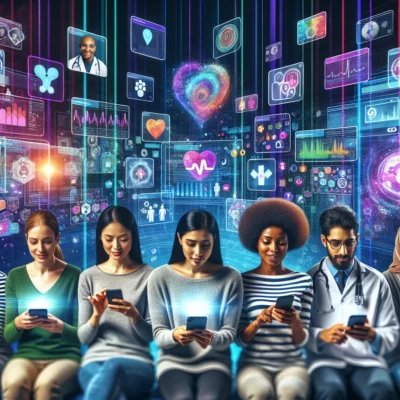Introduction: The Shift to Patient-Centric Healthcare
The healthcare landscape is undergoing a transformative shift from traditional models to next-generation, patient-centric approaches. Historically, healthcare has been provider-driven, with patients playing a passive role in their health management. However, the advent of advanced technologies and a growing emphasis on patient empowerment are reshaping this dynamic. Modern healthcare now prioritizes patient involvement, giving individuals greater control over their health decisions and outcomes.
Key Points:
- Traditional vs. Next-Gen Healthcare Models: Traditional models often involve in-person consultations and limited patient access to personal health data. Next-gen models leverage technology to provide continuous, real-time health monitoring and data access.
- Importance of Patient Empowerment: Empowering patients leads to better health outcomes, as individuals who are informed and engaged in their care are more likely to adhere to treatment plans and make healthier lifestyle choices.
- Technological Advancements: Innovations such as digital health platforms, telemedicine, wearable technology, and artificial intelligence are driving this shift towards a more patient-centric approach.
Digital Health Platforms: Your Health, Your Hands
Digital health platforms, including mobile health apps and personal health records (PHRs), are revolutionizing the way patients manage their health. These tools provide users with easy access to their medical history, real-time health tracking, and personalized health insights.
Examples of Popular Digital Health Platforms:
- MyChart: Allows patients to view test results, schedule appointments, and communicate with healthcare providers.
- Apple Health: Integrates health data from various sources, offering a comprehensive view of one’s health metrics.
- Fitbit: Tracks physical activity, sleep patterns, and other health metrics, providing personalized insights and recommendations.
Benefits:
- Real-Time Health Tracking: Continuous monitoring of health metrics helps in early detection of potential issues.
- Personalized Health Insights: Tailored recommendations based on individual health data promote better health management.
- Easy Access to Medical History: Patients can quickly access their health records, facilitating informed decision-making and improved communication with healthcare providers.
Telemedicine: Healthcare at Your Fingertips
Telemedicine has seen exponential growth, especially in the wake of the COVID-19 pandemic. It encompasses a range of services that allow patients to receive medical care remotely, enhancing accessibility and convenience.
Types of Telemedicine Services:
- Video Consultations: Virtual appointments with healthcare providers.
- Remote Monitoring: Continuous monitoring of patients’ health metrics using digital devices.
- E-Prescriptions: Digital prescriptions sent directly to pharmacies.
Enhancements:
- Accessibility: Patients in remote or underserved areas can access healthcare services without the need for travel.
- Convenience: Reduces the need for in-person visits, saving time and resources for both patients and providers.
Wearable Technology: Monitoring Health in Real-Time
Wearable health devices, such as fitness trackers and smartwatches, are becoming increasingly popular for real-time health monitoring. These devices track key health metrics, providing valuable data for proactive health management.
Key Metrics Monitored:
- Heart Rate: Continuous heart rate monitoring helps detect irregularities early.
- Sleep Patterns: Insights into sleep quality and duration.
- Physical Activity: Tracks steps, calories burned, and overall activity levels.
Impact:
- Proactive Health Management: Enables individuals to take preventive measures based on real-time data.
- Early Detection: Identifies potential health issues before they become serious, allowing for timely intervention.
AI and Machine Learning: Personalized Health Insights
Artificial intelligence (AI) and machine learning are playing a pivotal role in analyzing health data and predicting health trends. These technologies offer personalized health recommendations and assist in managing chronic conditions.
Examples of AI-Powered Tools:
- IBM Watson Health: Uses AI to analyze medical data and provide insights for treatment plans.
- Google Health: Develops AI algorithms for early detection of diseases and personalized health recommendations.
Assistance:
- Chronic Condition Management: AI tools help in monitoring and managing conditions like diabetes and hypertension.
- Optimized Treatment Plans: AI analyzes patient data to recommend the most effective treatment options.
Patient Education: Knowledge is Power
Health literacy and patient education are crucial components of patient empowerment. Digital resources and online platforms provide patients with the information they need to make informed decisions about their health.
Digital Resources:
- WebMD: Offers a wealth of information on various health conditions and treatments.
- Mayo Clinic: Provides expert advice and health information on a wide range of topics.
Empowerment:
- Informed Decision-Making: Patients with access to reliable health information are better equipped to make decisions about their care.
- Self-Care Practices: Educated patients are more likely to engage in preventive health measures and self-care practices.
Community and Support Networks: Building a Health Ecosystem
Online communities and support groups play a vital role in patient empowerment. These platforms facilitate interaction and support among patients, fostering a sense of community and shared knowledge.
Examples of Platforms:
- PatientsLikeMe: Allows patients to share experiences and support each other.
- HealthUnlocked: A social network for health, connecting patients with similar conditions.
Benefits:
- Shared Experiences: Patients can learn from others who have similar health conditions.
- Collective Knowledge: Access to a wealth of information and support from a community of peers.
Future of Patient Empowerment: What Lies Ahead
The future of patient-centric healthcare is promising, with emerging technologies and trends poised to further enhance patient empowerment. However, there are challenges to be addressed in implementing these solutions effectively.
Emerging Technologies and Trends:
- Blockchain for Health Records: Ensures secure and transparent access to health data.
- Virtual Reality (VR) for Therapy: Offers immersive experiences for mental health treatment and rehabilitation.
Potential Challenges:
- Data Privacy and Security: Ensuring the protection of sensitive health information.
- Digital Divide: Addressing disparities in access to digital health tools among different populations.
Vision:
A future where patients are at the center of their healthcare journey, empowered by technology and information to take control of their health and well-being.
By embracing next-generation solutions, we can create a healthcare ecosystem that not only treats illnesses but also empowers individuals to lead healthier, more informed lives. The journey towards patient-centric healthcare is just beginning, and the possibilities are limitless.
